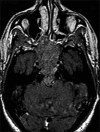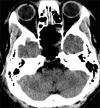Giant clival chordoma causing pathological laughter
- PMID: 24778906
- PMCID: PMC3994695
- DOI: 10.4103/2152-7806.127257
Giant clival chordoma causing pathological laughter
Abstract
Background: Chordomas are rare slowly growing tumors that originate from remnants of the notochord. They have a malignant local behavior, causing symptoms due to bone infiltration and compression of neurovascular structures. Only a few cases of brain tumors associated with pathological laughter have been reported in the literature.
Case description: We report a case of a 42-year-old male patient with this atypical clinical presentation treated at our institution, and discuss the concerning literature.
Conclusion: Although being a very rare presentation of chordomas, pathological laughter is usually expected to improve after brain stem decompression.
Keywords: Chordoma; clivus; pathological laughter.
Figures






References
-
- Borba LA, Al-Mefty O, Mark RE, Suen J. Cranial chordomas in children and adolescents. J Neurosurg. 1996;84:584–91. - PubMed
-
- Bhatjiwale MG, Nadkarni TD, Desai KI, Goal A. Pathological laughter as a presenting symptom of massive trigeminal neuromas: Report of four cases. Neurosurgery. 2000;47:469–72. - PubMed
-
- Cascino GD, Andermann F, Berkovic SF, Kuzniecky RI, Sharbrough FW, Keene DL, et al. Gelastic seizures and hypothalamic hamartomas. Evaluation of patients undergoing chronic intracranial EEG monitoring and outcome of surgical treatment. Neurology. 1993;43:747–50. - PubMed
-
- Garg RK, Misra S, Verma R. Pathological laughter as heralding manifestation of left middle cerebral artery territory infarct: Case report and review of literature. Neurol India. 2000;48:388–90. - PubMed
-
- Matsuoka S, Yokota A, Yasukouchi H, Harada A, Kadoya C, Wada S, et al. Clival chordoma associated with pathological laughter. Case report. J Neurosurg. 1993;79:428–33. - PubMed
Publication types
LinkOut - more resources
Full Text Sources
Other Literature Sources

